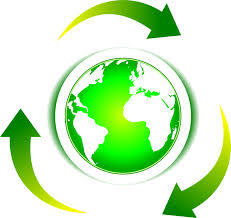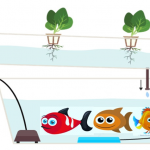As part of their course Current Trends in Leadership and Change (LFCS05), LFC students have written blog posts about resilience, circular economy practices, stakeholder relations, conflicts in organizations and relational frictions in European monarchies.
Wouldn’t it be great if in the contemporary world of sustainability awareness, different production and consumption functions would generate as little waste and loss as possible? Natural resources would be used sparingly, and materials would be utilised efficiently and sustainably. The harrowing truth is that humankind cannot endlessly use scarce natural resources – for this reason there is a strong demand for a dynamic change. Possibilities for such a change can be explored, for example, on the basis of global megatrends, consumer practices, as well as concepts that aim to be holistic and multidisciplinary. One such notable concept is the circular economy (CE).

Modifying the existing unsustainable economic model can be perceived as one of the most complex problems of our time; the economy outreaches biophysical boundaries of the planet and the current economy structure has raised serious environmental issues (Nylén, 2019). The concept of circular economy seeks to meet these challenges. The CE refers to an economic system based on business models that replace traditional end-of-life thinking in production and consumption processes. The CE builds on policies of reducing, alternatively reusing, recycling and recovering in various industrial processes. Utilizing and implementing these Rs at different levels of society, along other principles of sustainable development, would benefit present and future generations. (Kirchherr et al., 2017) In addition to the benefits of this material efficiency, the CE also offers social and economic benefits. Added value is usually generated for products or by-products with the help of services and digital solutions stemming from intelligence (Sitra, 2016).
The concept of CE has been, and continues to be, developed by various approaches from subjects such as economy, ecology, engineering, business and design, making the whole concept exceedingly multidisciplinary (Prieto-Sandoval et al., 2018). As also concretized in the Current Trends in Leadership and Change lecture on November 18th, Nylén (2019) describes the CE as an umbrella term or framework which brings together several useful and interrelated concepts. This blog post highlights a variety of interesting practices of operating in today’s complex environments with the principles of the circular economy in mind.
Plastics management
Indisputably, the present-day global economy relies heavily on plastic and so does our everyday life. However, the planet is drowning in plastic: over half of all the plastic produced worldwide lies in landfills and in the environment (Finnish Environment Institute, 2019a). In addition, there are also economic concerns linked to the way plastic is used: 95% of the value of plastic packaging material, which constitutes most of the plastic produced, is lost in the EU economy after a short first-use cycle (European Commission, 2018). Considering that less than 30% of plastic waste in the EU is even collected for recycling, “the new plastics economy” as advocated by the European Commission must be a circular economy (Calleja, 2019). The EU’s strategy for a circular plastics economy is visionary while, in reality, there are still limitations concerning plastic collection and recycling. In Finland, for instance, a survey has revealed that Finns sort plastic waste less conscientiously than they would like to due to a lack of suitable waste collection containers and collection points (Finnish Environment Institute, 2019b). As for recycling opportunities, most of the household waste consists of mixed types of plastics which need to be treated separately (Yle, 2017). However, as it is considered cost-ineffective to develop closed recycling systems for every type of plastic, researchers have developed chemical and mechanical methods to increase the recycling rate of such mixed plastics (Finnish Environment Institute, 2019a). In addition to logistics and the recycling technology itself, product design (European Commission, 2018) and consumer choices play a vital role: if businesses have an incentive to design or package their products in a way that the plastic waste resulting from them is easy to recycle – and consumers preferably choose these products over others – both stakeholder groups can contribute actively to making the plastic economy a more circular one.
Food waste
The main cause mentioned for climate change is often the combustion of oil and gas, but there is one factor that accounts for 10% of global energy consumption that most people are unlikely to have in mind: food waste (European Commission, 2019; FAO, 2017). Food waste is defined as “any food, or inedible parts of food, removed from the food supply chain to be recovered or disposed” (Närvänen, Mattila, & Mesiranta, 2019, p. 265). Considering the concept of circular economy, the aim should be to reduce the proportion of food waste disposed of to a minimum and to try to generate new value from inedible parts. This idea is also supported by Närvänen, Mesiranta, Mattila, and Heikkinen (2020), who call for a shift from the term “food chain” to the more holistic approach of “food system”, which implies a more circular use of food.
The change of food wasting behaviour towards a circle can happen on different levels, namely the personal level and the societal level (Närvänen et al., 2019). The individual level classifies customers into different types. Närvänen et al. (2019) introduce the so-called “consumer-citizen”, who, like consumers, generally behave in a self-oriented manner, but also have altruistic purposes in decision-making. In order not only to reduce food waste, but also to make the entire food process a cycle, individuals can, for example, build a compost container for organic waste in their garden and reuse the resulting soil for nurturing new plants.
The social level takes this idea to a higher level. “Insect-based bioconversion” is a fast-growing enterprise, which works like a compost bin and turns food waste into new materials (Fowles & Nansen, 2020). This involves feeding insects like the black soldier larvae with wasted food and ‘harvesting’ them when the larvae reach a certain stage of development. The larvae are then used as additives for animal feed, non-fossil biofuels, fertilisers and as proteins for human nutrition. Like a compost container, this process can be used in densely populated areas, providing an ideal solution not only to get rid of food waste, but also to circle the food chain and create new value from waste (Fowles & Nansen, 2020).
Smart Cities
According to the UN (2018), 55% of the world population lives in urban areas. In the EU, the percentage is even higher – 72% of its population are now living in cities, towns, and suburbs (Eurostat, 2016). As a result of continued urbanization, cities play a central role in shaping the global economy: they account for 85% of global GDP, 75% of natural resource and energy consumption, half of global waste production, and they emit around 60% of the world’s total greenhouse gases. However, cities do not only create challenges, but can also offer great opportunities and solutions, as most of the resources, data, wealth, and innovation centers are concentrated in the cities. For this reason, a sustainable urban development or the concept of smart city has become an integral part of a transition towards CE.
Finland, aiming to become a leader in the transition to CE, is now building a whole new city district in Western Tampere based on the former Lielahti industrial area. The name of the district is Hiedanranta. It is planned to create 10000 new jobs and become a home for 25000 residents (City of Tampere, 2019). The city of Tampere designs the project by collaborating with citizens, start-ups, businesses, and other stakeholders. Hiedanranta’s ambitious goal is to produce more than it consumes. The new district has become a place for various innovative projects and experiments in the new forms of food and energy production, waste management, circulation of nutrients, architecture innovations, etc. Some of the examples are Evergreen Farm which is cultivating strawberries based on a closed cycle (through production of nutrients by collecting the urine from dry toilets) and AI; Dynamo project which is aimed to develop a production of organic fertilizers from the waste fiber; and Edible Park where local residents can grow edible plants for consumption (City of Tampere, 2019). The construction of the city district will begin in 2020-2021.
Aquaponics
Another aspect a smart city could implement in order to tackle several issues such as food security, soil degradation and water scarcity is aquaponics. This closed-loop system combines hydroponics, which is the process of growing plants without soil (Merriam-Webster’s collegiate dictionary, 2019) and aquaculture (Palma Lampreia dos Santos 2016, p. 403). The fish waste is used as a fertilizer to make the plants grow. As a result of this, the water cleaned by the plants can be used in the fish tanks all over again. (Milicic et al. 2017, p. 2) Harvesting vegetables and fish at the same time, adding almost no new water and pesticides is perfectly in line with the concept of circular economy. Additionally, the technique incorporates other benefits for densely populated areas, such as a small usage of space, the ability to pile the aquariums and independence from weather conditions due to inside farming.

(A Complete Guide to Aquaponic Gardening. Max, 2019)
Conclusion
The blog post demonstrated how the principles of CE can be applied in different areas, such as plastics management, food waste, smart cities, and aquaponics. Whereas CE principles are slow to gain ground when it comes to the management of plastics, food waste can be considerably reduced by applying CE thinking on an individual and societal level. Equally, Smart Cities provide opportunities for CE implementation as the examples of the planned city district in Tampere, Hiedanranta, and Aquaponics illustrate. A bottom-up approach, building on the involvement of citizens and consumers alike, is a decisive factor in making circular economy a reality.
This blog post was compliled by Tatjana Blum, Nele Hapig, Teemu Korvenpää, Petrus Niemelä, Valentyn Nizyev and Marc Wolsztynski.
References
Calleja, D. (2019). Why the “New Plastics Economy” must be a circular economy. Field Actions Science Reports, 19, pp. 22–27.
City of Tampere (2019). Planning of the city district. https://www.tampere.fi/en/housing-and-environment/city-planning/development-programs/hiedanranta/planning.html
Ellen MacArthur Foundation (2019). Cities and circular economy for food. https://media.sitra.fi/2019/01/24094741/cities-and-circular-economy-for- food.pdf
European Commission (2018). A European strategy for plastics in a circular economy. https://ec.europa.eu/environment/circular-economy/pdf/plastics-strategy-brochure.pdf
European Commission (2019). Causes of climate change. https://ec.europa.eu/clima/change/causes_en
Eurostat (2016). Urban Europe. Statistics on cities, towns and suburbs. Luxembourg. https://ec.europa.eu/eurostat/documents/3217494/7596823/KS-01-16-691-EN-N.pdf
FAO (2017). The future of food and agriculture – Trends and challenges. www.fao.org/3/a-i6583e.pdf
Finnish Environment Institute (2019a). The environmental impact of plastic packaging can be halved in the next ten years. https://www.materiaalitkiertoon.fi/enUS/Current/The_environmental_impact_of_plastic_pack
Fowles, T. M., & Nansen, C. (2020). Insect-based bioconversion: Value from food waste. In E. Hydroponics (n.d.) in Merriam-Webster’s collegiate dictionary. https://www.merriam-webster.com/dictionary/hydroponics
Kirchherr, J., Reike, D., & Hekkert, M. (2017). Conceptualising the circular economy: An analysis of 114 definitions. Resources, Conservation & Recycling, 127, pp. 221–232.
Max. (2019). A complete guide to aquaponic gardening. https://www.greenandvibrant.com/aquaponic-gardening
Milicic, V., Thoraninsdottir, R., Lampreia Dos-Santos, M., & Turnsek, M. (2017). Commercial aquaponics approaching the European market: To consumers’ perceptions of aquaponics products in Europe. Water, 9(2), pp. 1–22.
Närvänen, E., Mattila, M., & Mesiranta, N. (2019). Consumer-citizens as leaders of change: The case of food waste. In A. Kangas, J. Kujala, A. Heikkinen, A. Lönnqvist, H. Laihonen, & J. Bethwaite (Eds.), Leading change in a complex world: Transdisciplinary perspectives (pp. 263–280). Tampere: Tampere University Press.
Nylén, E-J. (2019). Can abstract ideas generate change? The case of the circular economy. In A. Kangas, J. Kujala, A. Heikkinen, A. Lönnqvist, H. Laihonen & J. Bethwaite (Eds.), Leading change in a complex world: Transdisciplinary perspectives (pp. 281–299). Tampere: Tampere University Press.
Palma Lampreia dos Santos, M. (2016). Smart cities and urban areas – Aquaponics as innovative urban agriculture. Urban Forestry & Urban Greening, 20, pp. 402–406.
Prieto-Sandoval, V., Jaca, C., & Ormazabal, M. (2018). Towards a consensus on the circular economy. Journal of Cleaner Production, 179, pp. 605–615.
Sitra. (2016). Leading the cycle: Finnish road map to a circular economy 2016–2025. https://www.sitra.fi/en/publications/leading-cycle/


Comments